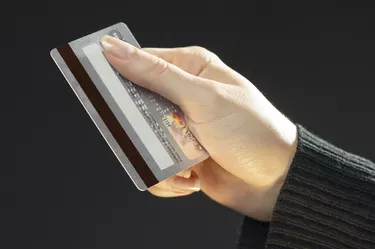
Credit and debit card fraud is more rampant than ever, and companies have to upgrade their security measures often. One older method used for security was adding an issue number on cards. These indicated whether or not the card had been replaced or reissued to a customer. If a card was lost or expired, a new one would be sent out with the same account number but with an issue number on the end, starting with 0 or 1 for most cards.
Visa Card Issue Numbers
Video of the Day
In the past, credit card companies kept the original account numbers, added the issue number on cards and changed the expiration dates and CVC/CVV numbers when sending out new cards. While this practice is still going on in some countries, issue numbers are rarely found on U.S. and Canadian credit and debit cards like Visa and Mastercard. You will not see Visa card issue numbers today. These digits are also not found often on cards in Europe and the U.K. either.
Video of the Day
Many people confuse CVC/CVV numbers with the idea of issue numbers, but the two are different. If there is an issue number, it would be on the front of the card or on the bottom right corner. Issue numbers are usually one or two digits, such as 2 or 02. It is unlikely to find one, though, since credit card companies do not rely on these anymore.
Visa Gift Card Issue Numbers
Visa gift cards and Visa debit cards do not have issue numbers, either. They do have expiration dates and CVV codes, though. Visa gift cards are good for seven years, according to WSECU Credit Union. However, the funds do not actually expire; a new card can be reissued in most cases. These prepaid cards can be used anywhere that Visa is accepted. When purchases are made, they are deducted from the balance.
Visa debit cards also have expiration dates and CVV numbers. These cards are linked to checking or savings accounts. Whenever purchases are made, the money comes out of those accounts right away. Many people prefer to use debit cards instead of writing checks because it is fast and easy.
How do CVV Codes Work?
LifeLock posts that credit and debit cards have unique CVV codes (CVV stands for card verification value, by the way), which provide added security for retailers. This information is matched up with the account number, the person's name and the expiration date. CVVs are used when consumers make purchases on the phone or online.
Visa, MasterCard and Discover use three-digit CVV numbers on their credit and debit cards, while American Express cards use four digits. When cards are lost or stolen, though, the CVV cannot provide that added protection because other people can easily locate the information on the cards. Some criminals also find ways to use stolen cards to make phone and online purchases without CVV numbers. Basically, it is an added layer of protection but is not foolproof. Cybercriminals are also able to use malware to steal security codes from online retailers; it really is a never-ending battle.
To keep credit, debit and gift cards safe, U.S. News & World Report advises consumers to never share the expiration dates or CVV codes with people or companies they are not familiar with. It is also unwise to share photos of these cards on social media. Only shop on secure websites and never provide sensitive credit card information to unknown sources. Antivirus software can also be installed to shield credit card information when shopping online; also, remember to check your statements often.